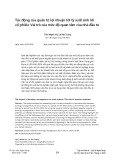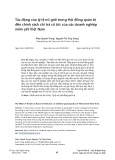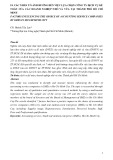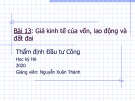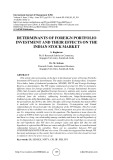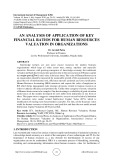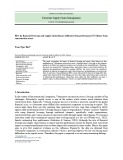
http://www.iaeme.com/IJM/index.asp 39 editor@iaeme.com
International Journal of Management (IJM)
Volume 10, Issue 2, March-April 2019, pp. 39-46, Article ID: IJM_10_02_004
Available online at http://www.iaeme.com/ijm/issues.asp?JType=IJM&VType=10&IType=2
Journal Impact Factor (2019): 9.6780 (Calculated by GISI) www.jifactor.com
ISSN Print: 0976-6502 and ISSN Online: 0976-6510
© IAEME Publication
FINANCING CURRENT ASSETS DECISION IN
WORKING CAPITAL MANAGEMENT: AN
EVALUATION
Dr. G. Rajendran
Associate Professor, P.G. Department of Commerce,
Jawaharlal Nehru Govt. College, Port Blair, 744104, A&N Islands,
Affiliated to Pondicherry University, A Central University, India
ABSTRACT
The investment in current assets is imperative for the day-to-day operations of a
business concern. It determines the liquidity and the profitability of the business
concern. Financing current assets is a challenging task but this is one of the significant
aspects of working capital management. It involves a crucial financial decision. There
are various approaches available in determining an appropriate mix of financing
current assets, but none of the approaches is completely satisfactory and acceptable.
The present paper focuses on the real corporate world practices regarding financing
current assets decision in working capital management. The main aim is to enlighten
the shareholders, creditors, investors, bankers, prospective entrepreneurs, students and
academicians relating to financing current assets decision and its implications. The
study would reveal how far, the profit available and risk associated with the financing
mix and a trade-off between risk and return will result in an acceptable financing
strategy for most of business concerns.
Keywords: investment in current assets, Working Capital Management, Financing
Current Assets.
Cite this Article: Dr. G. Rajendran, Financing Current Assets Decision in Working
Capital Management: An Evaluation, International Journal of Management, 10 (2),
2019, pp. 39-46.
http://www.iaeme.com/IJM/issues.asp?JType=IJM&VType=10&IType=2
1. INTRODUCTION
The working capital management is concerned with the management of current assets. It is an
integral part of the overall financial management. It is concerned with determination,
maintenance, control, and monitoring of level of all individual current assets. The efficient
management of working capital is important from the point of view of liquidity and
profitability. Every firm must maintain a sound working capital position. It is an index of the
solvency of the business. Poor working capital management, on the other hand, reduces
liquidity and also reduces the ability to invest in productive assets, so affects the profitability
since funds are unnecessarily tied up in idle assets.

Financing Current Assets Decision in Working Capital Management: An Evaluation
http://www.iaeme.com/IJM/index.asp 40 editor@iaeme.com
Fixed assets cannot work without working capital. Without it, fixed assets are like guns
which cannot shoot as there are no cartridges. By maintaining adequate working capital, the
concern enjoys and avails of so many benefits such as solvency, credit worthiness, and discount
facilities due to prompt payment, expansions programmes, research and development.
However, the excess working capital may result in unnecessary accumulation of inventories
resulting in waste, damages and delays in collections of receivables due to more liberal credit
terms. Inadequate working capital, on the other hand, may result in many consequences such
as under utilisation of capacity, technical insolvency, unable to meet demand etc. So, a firm
must have a well-defined working capital policy and a sound working capital management
system to ensure higher profitability and adequate liquidity.
Financing of current assets has become the most crucial decision-making in the
management of working capital. It refers to how current assets are financed i.e., the source from
which it is financed. In other words, it is concerned with deciding the financing mix of working
capital. It involves which component of working capital is financed by what source. Such a
decision is taken in the light of risk and return associated with each source of finance. For the
financial success of a firm, a trade-off between risk and return in choosing the most acceptable
financing mix of working capital is essential.
2. OBJECTIVES OF THE STUDY
To study the importance of financing working capital.
To analyse the pattern of financing current assets of selected public limited companies.
3. DATA BASE AND METHODOLOGY
The present study is based on secondary data. The relevant secondary data was collected from
annual reports of Hero Motorcorp Limited, Bajaj Auto Company Limited and TVS Motor
Company Limited, books, journals, magazines and other documents. This is an analytical study
of the financing pattern of current assets of Hero Motorcorp Limited, Bajaj Company Limited
and TVS Motor Company Limited for the period of 10 years from 2008-2009 to 2017-2018.
3.1. Tools for Analysis
Ratio analysis has been used as a tool of evaluating the financing pattern of current assets of
Hero Motorcorp Limited, Bajaj Auto Company Limited and TVS Motor Company Limited.
Statistical tools such as averages, percentages have been used to quantify the data.
3.2. Limitation of the study
The present paper attempts to examine the perspective of financing pattern of current assets in
the management of working capital of Hero Motorcorp Limited, Bajaj Auto Company Limited
and TVS Motor Company Limited. All other aspects of working capital management of Hero
Motorcorp Limited, Bajaj Auto Company Limited and TVS Company Limited have not been
focused in this paper for the present study.
3.3. Financing Current Assets Decision
The most crucial decision-making in the management of working capital is financing of current
assets. It is concerned with deciding the financing mix of working capital. It involves which
component of working capital is financed by what source. There are two components of
working capital namely permanent working capital and temporary working capital. The
minimum level of current assets which must be maintained by any firm all the times in order to
meet its business requirements is known as permanent working capital. The additional working
capital needed over and above the permanent working capital to support the increased volumes

Dr. G. Rajendran
http://www.iaeme.com/IJM/index.asp 41 editor@iaeme.com
of sales is known as temporary working capital. There are two main sources of financing
working capital namely Long-term sources and short -term sources. Each source of finance has
its own merits and demerits.
Financing of working capital from short-term sources has benefits low cost and establishing
close relationship with the banks. But short-term source are more risky. Financing of working
capital from long-term sources has the benefits of low risk and more liquidity since repayment
of loans is not at frequent interval. But long-term sources are high cost. It will be appropriate
to finance at least 2/3 of the permanent working capital requirements from long-term sources.
The variable working capita should be financed from short-term sources only for the period
needed. There is no ideal set or combinations of these sources. There are three different
approaches namely Hedging Approach, Conservative Approach and Aggressive Approach to
take this decision relating to financing mix of the working capital.
The Hedging Approach involves matching the maturity of source of funds with the nature
of assets to be financed. This approach is also known as ‘Matching Approach’ since the length
of the finance should match with life duration of assets. According to this approach, the duration
of working capital needs are classified into permanent working capital and temporary working
capital. Permanent working capita refers to the constant portion of working capital needs of a
business concern over a period of time. Temporary working capital refers to the additional
working capital needs of a business concern in order to finance additional production and sales
due to seasonal changes in demand. According to this approach, the permanent working capital
needs should be financed from long term sources of funds and the temporary working capital
requirements should be financed from short- term sources of funds. The Conservative Approach
is a traditional approach under which all the working capital needs are primarily financed by
long-term sources and use of short term sources should be restricted to unexpected and
emergency situation only. The Aggressive Approach determines to finance a part of the
permanent working capital and seasonal working capital by short term sources.
The hedging approach is a high profit (low cost)- high risk (No NWC) category while the
conservative approach is a low profit(high cost) –low risk(high NWC) category. The hedging
and the conservative approaches are both on two extremes. They do not help in efficient
working capital management. A trade-off between these two can give satisfactory results.
The conservative approach is a low risk – low profit (high cost - high NWC) while the
aggressive approach is a high risk- high profit (low cost – low NWC). A trade-off between these
two extremes also can give acceptable financing strategy.
3.4. Analysis of the Pattern of Financing Current Assets
The pattern of financing current assets of f Hero Motorcorp Limited, Bajaj Auto Company
Limited and TVS Company Limited has been analyzed with the help of analytical tools ,‘ the
ratio of short-term funds to total funds and’ the ratio of current assets to current liabilities‘ as
below:
3.5. Short-term Funds to Total Funds Ratio
This ratio expresses the proportion of short-term funds to total funds. The main purpose of this
ratio is to evaluate the method of financing policies by a firm. The ratio is computed as follows.
Short-term Funds to Total Funds Ratio = Short -term Funds
Total Funds
The lower the ratio, the less risky as well as less profitable will the firm but with more cost.
The reason is that long-term funds are less risky but more cost. So, there will be a conservative
financing policy which relies less on short-term funds and more on long-term funds. In contrast,
the higher the ratio, the more risky as well as more profitable will be the firm with a low cost

Financing Current Assets Decision in Working Capital Management: An Evaluation
http://www.iaeme.com/IJM/index.asp 42 editor@iaeme.com
as short-term funds are more risk but less expensive than long-term funds. It indicates the
presence of an aggressive financing policy which relies heavily on short-term funds and less on
long-term funds.
3.6. Current Assets to Current Liabilities
Current Ratio is the most popular ratio among the ratios of liquidity. It is the ratio of current
assets to current liabilities.
The main purpose of this ratio is to measure, the short-term solvency position of a firm ,the
source from which the current assets have been financed and the risk and return involved in
financing current assets.. The ratio is computed as below:
The standard for this ratio is 2:1. A high current ratio more than 2 times indicates that the
company’s liquidity position is sound and it has ability to pay its current obligations. The
company uses the whole of short-term funds to finance current assets and a portion of long-
term funds to finance current assets. It depends more on long-term funds to finance current
assets. A low current ratio below 2 times, on the other hand, indicates that the company’s
liquidity position is not sound and it will find difficulty in paying its current liabilities. The
company uses the whole of short-term funds to finance current assets and a portion of long-
term funds to finance current assets. It relies less on long-term funds than short-term funds to
finance current assets. However, a very high current ratio reduces the profitability of the
concern since it depends more on long-term funds, for working capital which are costly. A very
low current ratio below 1 indicates that the company bears even greater risk of insolvency in
order to save cost of long term financing and thus in order to earn greater return.
Table-1 Exhibits the Short-term Funds to Total Funds Ratio and Current Assets to Current
Liabilities Ratio of Hero Motorcorp Limited as below:
Table 1 Short-Term Funds to Total Funds Ratio and Current Assets to Current Liabilities Ratio of
Hero Motorcorp Limited 2008-2009 To 2017-2018
Year
Short-term Funds
Rs in corer
Total Funds
Rs in corer
Current Assets
Rs in corer
Short-term
Funds to Total
Funds Ratio(in
Percentage)
Current
Assets to
Current
Liabilities
Ratio(in
times)
2008-2009
2052.82
6085.14
1013.49
33.74
0.49
2009-2010
4831.41
8523.09
2882.58
56.69
0.60
2010-2011
6016.71
10726.26
5771.84
56.09
0.96
2011-2012
4341.44
9888.92
4830.96
43.90
1.11
2012-2013
4170.68
9641.65
5077.61
43.26
1.22
2013-2014
4423.00
10097.30
5555.88
43.80
1.26
2014-2015
3883.42
10521.70
5282.13
36.91
1.36
2015-2016
4048.82
12340.69
5935.09
32.81
1.47
2016-2017
4093.33
14694.26
7453.18
27.86
1.82
2017-2918
4343.32
16738.80
8848.18
25.95
2.04
____
____
___
40.10
1.23
Source: Compiled and computed from the Annual Reports of Hero Motorcorp Limited.
- Stands for Arithmetic Mean.
From the above Table -1, it is clear that the ratio of short-term funds to total funds has been
fluctuating between 43.90 percent and 25.95 percent except in the year 2009-2010, 2010-2011
with a mean figure of 40.10 percent. In the year 2009-2010, it was 56, 69 percent and in the
year 2010-2011, it was 56.09 percent. It indicates that there is a low short-term funds to total
Current Ratio = Current Assets
Current Liabilities

Dr. G. Rajendran
http://www.iaeme.com/IJM/index.asp 43 editor@iaeme.com
funds ratio in most of the years. This means that the company has used an average of 40.10
percent to finance the total assets from short-term funds and an average of 59.90 percent to
finance the total assets from long-term funds in most of the years. The financing mix of total
assets, therefore, involves a high cost but a low risk.
The ratio of current assets to current liabilities has been fluctuating between 2.04 times and
1.11 times except in the year 2008-2009, 2009-2010 and 2010-2011with a mean figure of 1.23
times. In the year2008-2009, it was 0.49 times. In the year 2009-2010, it was 0.60 times and in
the year 2010-2011, it was 0.96 times. The ratio has been much below 2 times in most of the
years against the standard norm of 2:1. The company has used 0.49 times or 49 percent of the
short-term funds to finance current assets and 0.51 times or 51 percent of the short-term funds
to finance fixed assets in the year 2008-2009. It has used 0.60 times or 60 percent of the short-
term funds to finance current assets and 0.40 times or 40 percent of the short-term funds to
finance fixed assets in the year 2009-2010. It has used 0.96 times or 96 percent of the short-
term funds to finance current assets and 0.04 times or 4 percent of the short-term funds to
finance fixed assets in the year 2010-2011.
The company has used the whole short- term funds to finance current assets during the
period 2011-2012 to 2017-2018. It has also used a part of long-term funds to finance current
assets varying from 0.11 times or 11 percent to 1.04 times or 104 percent of current liabilities
during the period 2011-2012 to 2017-2018. The company has followed neither conservative
approach nor aggressive approach in financing current assets. The company has, therefore,
followed the most acceptable financing mix of current assets policy and practice by a trade-off
between risk and return. This financing mix of current assets may help in efficient working
capital management of the company.
Table-2 Exhibits the Short-term Funds to Total Funds Ratio and Current Assets to Current
Liabilities Ratio of Baja Company Limited as below:
Table 2 Short-Term Funds to Total Funds Ratio and Current Assets to Current Liabilities Ratio of
Baja J Company Limited 2008-2009 to 2017-2018
Source: Compiled and computed from the Annual Reports of Bajaj Company Limited.
- Stands for Arithmetic Mean.
From the above Table -2, it is clear that the ratio of short-term funds to total funds has
been fluctuating between 41.74 percent and 15.43 percent except in the year 2008-2009, 2009-
2010 with a mean figure of31.85 percent. In the year 2008-2009, it was44.45 percent and in the
year 2009-2010, it was49.10 percent. It indicates that there is a low short-term funds to total
Year
Short-term Funds
Rs in corer
Total Funds
Rs in corer
Current Assets
Rs in corer
Short-term
Funds to Total
Funds Ratio(in
Percentage)
Current Assets
to Current
Liabilities
Ratio(in times)
2008-2009
2686.06
6042.42
2240.85
44.45
0.83
2009-2010
4287.95
8733.70
2921.63
49.10
0.68
2010-2011
3855.47
9247.53
3031.15
41.69
0.79
2011-2012
4625.16
11081.07
5190.15
41.74
1.12
2012-2013
4133.63
12478.62
6198.08
31.13
1.50
2013-2014
4730.24
14747.60
5616.63
32.07
1.19
2014-2015
4476.79
15562.32
9526.27
28.77
2.13
2015-2016
2780.99
16486.50
4725.25
16.87
1.70
2016-2017
3212.58
20814.89
9391.37
15.43
2.92
2017-2918
4111.29
23819.49
9235.63
17.26
2.25
31.85
1.51


